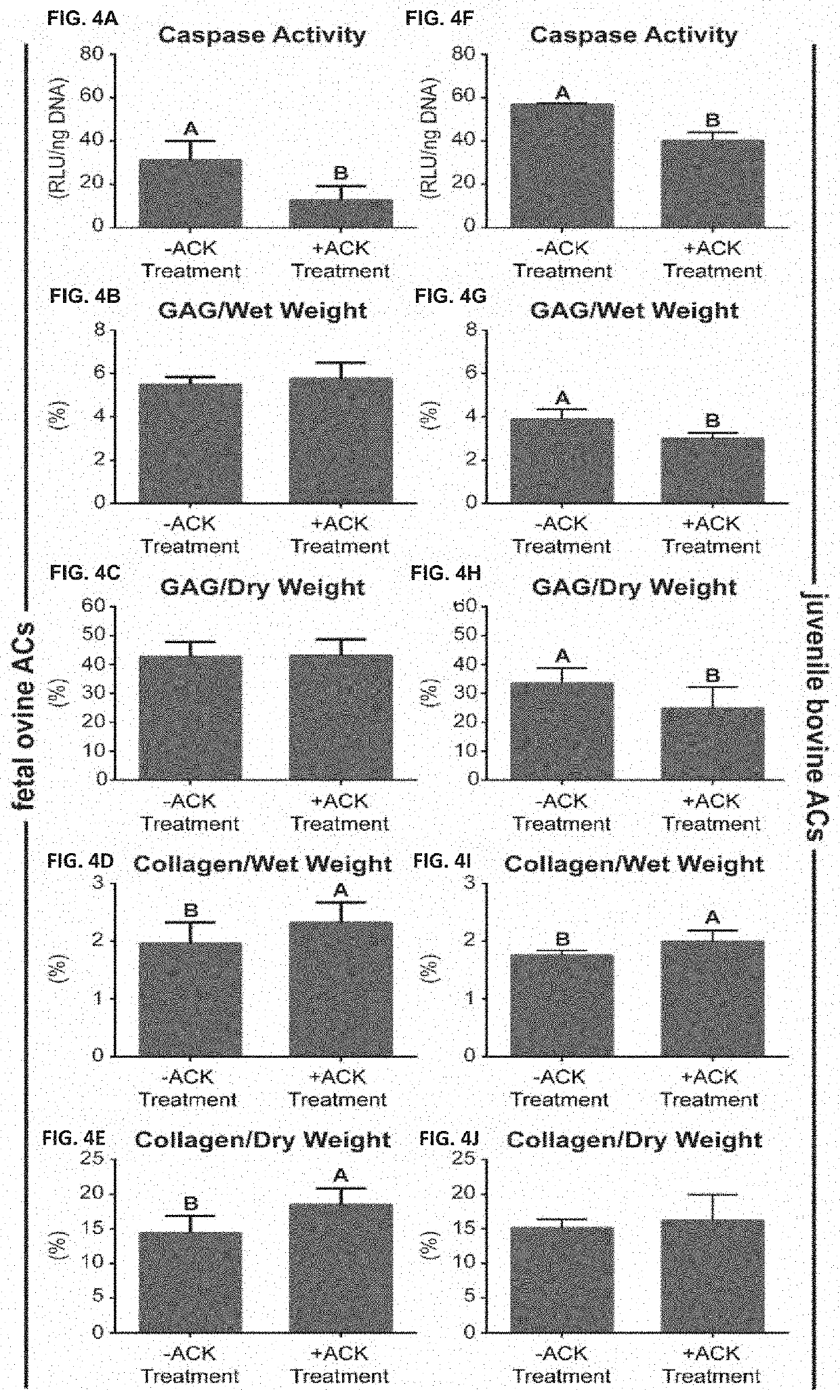Methods and systems for improving cells for use in therapy
a cell and cell technology, applied in the field of cell purification methods, can solve the problems of unwanted cell phenotypes in cartilage cells, necrosis at the wound edge, wave of apoptosis extending into the tissue, and heterogeneity of phenotypes, so as to enhance the capacity to form biofunctional tissues, improve the mechanical properties of neotissue, and avoid the effect of neotissue formation
- Summary
- Abstract
- Description
- Claims
- Application Information
AI Technical Summary
Benefits of technology
Problems solved by technology
Method used
Image
Examples
example 1
Solution
[0144]Example 1 describes methods of using a hypotonic solution to select cells based on cytoskeletal properties. Example 1 shows that treatment with the hypotonic solution, ACK buffer, of freshly isolated, fully differentiated cells, enhances their capacity to form biofunctional tissues. Clinically relevant articular chondrocytes (ACs) from fetal and juvenile cartilage were used as the model in the following studies: Fetal ovine articular chondrocytes (foACs) were treated with ACK buffer during their isolation. Without wishing the Invention to any particular theory or mechanism, it is believed that treatment of cartilage cells with a hypotonic buffer is effective to increase viable chondrocyte purity by reducing the number of cells with pre-existing undesirable cytoskeletal characteristics. Therefore, this treatment produces a population of cells, enriched for viable chondrocytes without undesirable cytoskeletal characteristics, thereby increasing the functional properties ...
example 2
[0160]Example 2 describes methods of using shearing to select cells based on cytoskeletal properties. Example 2 shows a protocol by which to purify articular chondrocytes with the application of shear.
[0161]Cell isolation: Juvenile ovine articular chondrocytes (joACs) are to be isolated from the femoral condyles and trochlear groove of juvenile Rambouillet Suffolk cross sheep to be obtained from a local abbotoir (Nature's Bounty Farms, Dixon, Calif.) within the same day of animal sacrifice. Cartilage is to be minced into 1-2 mm3 cubes and washed two times with wash medium (Dubelco's Modified Eagle Medium; DMEM containing 1% (v / v) PSF). Minced cartilage is to be digested with 500 units / mL collagenase type 2 (Worthington Biochemical) in chondrogenic medium+3% (v / v) fetal bovine serum (FBS: Atlanta Biologicals) for 18 hours at 37° C. and 10% CO2 on an orbital shaker. Cells are then to be strained through a 70 μm strainer and counted.
[0162]Protocol for introducing shear to purify chondr...
example 3
mpression
[0163]Example 3 describes methods of using an impact / compression to select cells based on cytoskeletal properties. Example 3 shows a protocol by which to purify articular chondrocytes with the application of compression / impact.
[0164]Cell isolation: Juvenile ovine articular chondrocytes (joACs) are to be isolated from the patellofemoral surfaces of 1-year-old Rambouillet Suffolk cross sheep to be obtained from a local abattoir (Superior Farms, Dixon, Calif.) within 48 hours of slaughter (n=8). Cartilage from the surface of both condyles and the trochlear groove is to be minced into approximately 1 mm3 pieces and washed three times with Dulbecco's Modified Eagle Medium containing 4.5 g / L glucose and GlutaMAX (DMEM: Gibco) and 2% (v / v) penicillin / streptomycin / fungizone (PSF; Lonza). The cartilage is then to be digested in 02% (w / v) collagenase type II (Worthington) in DMEM containing 3% (v / v) fetal bovine serum (FBS; Atlanta Biologicals) for 18 hours at 37° C. with gentle rock...
PUM
 Login to view more
Login to view more Abstract
Description
Claims
Application Information
 Login to view more
Login to view more - R&D Engineer
- R&D Manager
- IP Professional
- Industry Leading Data Capabilities
- Powerful AI technology
- Patent DNA Extraction
Browse by: Latest US Patents, China's latest patents, Technical Efficacy Thesaurus, Application Domain, Technology Topic.
© 2024 PatSnap. All rights reserved.Legal|Privacy policy|Modern Slavery Act Transparency Statement|Sitemap



